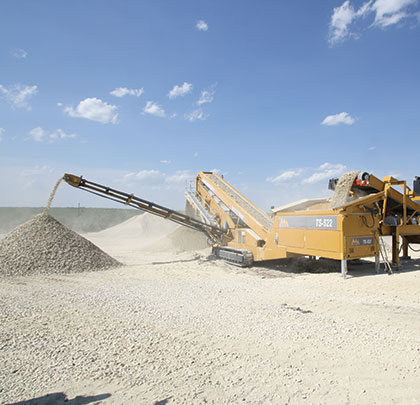Part 1: Selecting The Right Crusher For An Operation
Crushing rock is an age-old idea. Look at the childhood favorite cartoon, “The Flintstones,” and you’ll see the idea began in prehistoric times. But the reality of the task is a far cry from that of Fred and Barney.
Crushing is really a science. Finding the right solution to maximize productivity, while minimizing maintenance, requires more than a large dinosaur. Selecting the right equipment can make the difference between profitability and growth or frustration and financial woes. Several critical factors must be considered, including output needs, materials, applications, and machine design.
APPLICATION
The first and most fundamental aspects to consider are application and material. The most critical factor with material is hardness. The hardness of the material is typically measured in compressive strength, or the maximum force that material can withstand before breaking. The hardness levels can range from that of concrete at 7,000 psi to 50,000 psi for ores or other hard materials. The harder the material, the longer it may take to crush. Hardness also influences the specific crusher for the operation.
Jaw Crushers:
Jaw crushers crush material using compressive force. These crushers offer an ideal solution for primary crusher applications involving hard, abrasive materials, such as granite, ores, or recycled concrete. Efficient and less costly to operate because of their minimal moving parts, jaw crushers are ideally suited for applications where the primary objective is reducing raw feed material into a manageable size, usually down to about 6 inches.
While the units may be appealing due to their lower operating costs, they are not well suited for applications that require smaller material sizing and are therefore used in conjunction with other crushers. Another critical application factor to note is that jaw crushers do not perform well with contaminated materials such as clay, dirt, or even metal debris.
Cone Crushers:
Cone crushers, also known for their ability to crush hard, abrasive ores and rocks, break material by squeezing or compressing it between convex and concave shaped surfaces. Best suited for secondary crushing applications, cone crushers are built to crush presized materials, usually 4, 6, or 8 inches, depending on the size of the crusher. Cone crushers can form a finished product down to ½-inch minus.
Like the jaw crusher, cone crushers provide a relatively low-cost crushing solution, but there are application drawbacks. First, any material fed to a cone crusher must be presized for that particular crusher, usually 8 inches or less. In addition, the cone crusher will not produce a consistent cubicle product. Finally, these units, like the jaw crushers, are not suitable for handling clay and metal mixed in with the concrete, rock, or minerals.
Impact Crushers:
Designed to fill the gap left in the market by the cone and jaw crushers, horizontal impact crushers (HSIs) are ideally suited for contaminated materials and can easily process metals such as rebar, wire mesh, and dowel pins. HSIs produce a uniform cubicle product and can tackle high reduction ratios allowing them to accept all in-feed, providing maximum productivity in both primary and secondary applications. While HSI units can handle hard material, they are ideally suited for soft to medium rock.
HSI crushers consist of a rotor attached to a horizontal rotating shaft. The shaft is placed inside a chamber, which is lined with replaceable liner plates, anvils, and blow bars. The material is fed into the top of the chamber where it impacts the rotor. The rotor then throws the material outward against the curtain anvils. Repeated impact against the curtain anvil by the blow bars reduces the material to the desired size. Material sizing is achieved by rotor rotational speeds and adjustments of the clearance between the blow bars and curtains. The nature of HSI crushing can lead to slightly higher operating costs, the cost incurred for greater versatility and uniform product sizing.
MACHINE SIZE AND OUTPUT
Companies should take the time to calculate their desired tonnages per month. For example, if a company can sell 500,000 tons per year, its crushers need to produce just short of 42,000 tons each month. If the crusher is set up to run 3 days per week (approximately 13 days per month) for 8 hours per day, the operation will require a machine capable of processing 400 tons per hour (TPH). A crusher that is too small will fail to produce the desired tonnages limiting yields and profits and capping the growth potential of the organization. A machine that’s too large carries extra expense with no added value.
Each crusher’s maximum TPH output is determined when the machine is at or close to full capacity. Failing to maintain a full load results in improper wear and inefficient crusher operation. Using a machine capable of processing 450 TPH to perform at a much lower rate, such as 50 TPH, will result in visible signs of irregular wear patterns, leading to costly repairs to the crusher. That being said, it is important to review the business plans, calculate short-term growth initiatives, and buy a machine sized to allow for that growth, while still maximizing efficiencies. ■
Click Here to view Part 2 of “Flintstone to Finesse” which covers the number of products an operator is producing, mobile crushers, and other critical components to evaluate when selecting a crusher.
About The Author:
Sean Donaghy, IROCK Crushers national sales manager, has been in the crushing and screening industry for 24 years, 7 of which with IROCK Crushers. IROCK works towards being the market leader in wheeled crushing equipment with a focus on customer values. For more information, visit www.irockcrushers.com.
_________________________________________________________________________
Modern Contractor Solutions, March 2013
Did you enjoy this article?
Subscribe to the FREE Digital Edition of Modern Contractor Solutions magazine.

From Flintstone To Finesse


